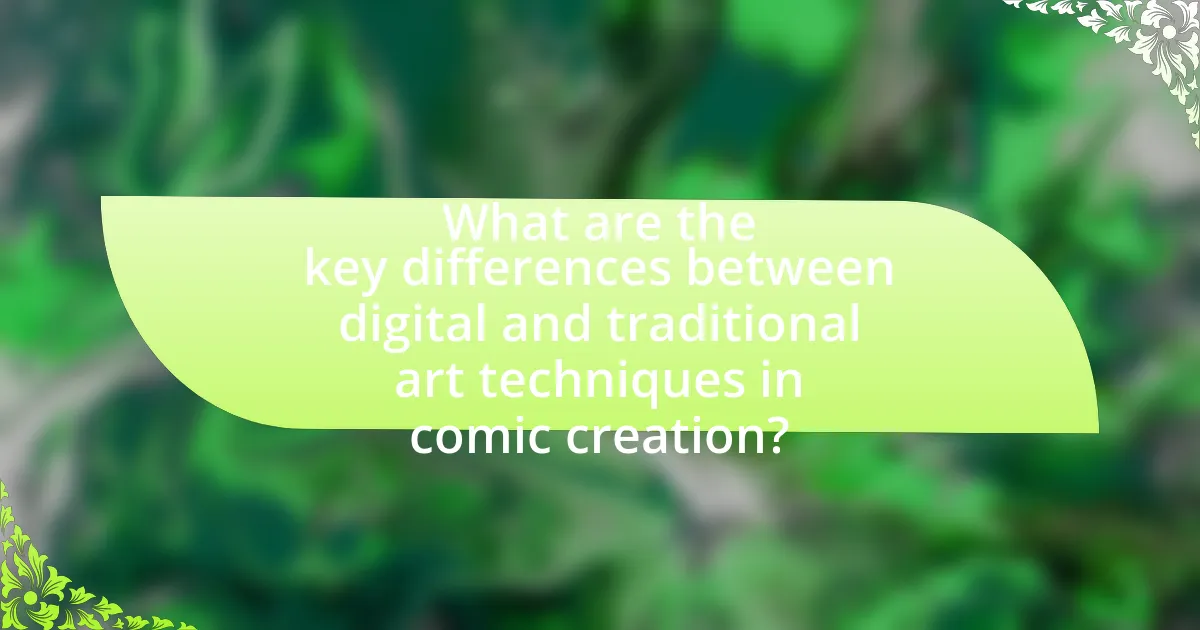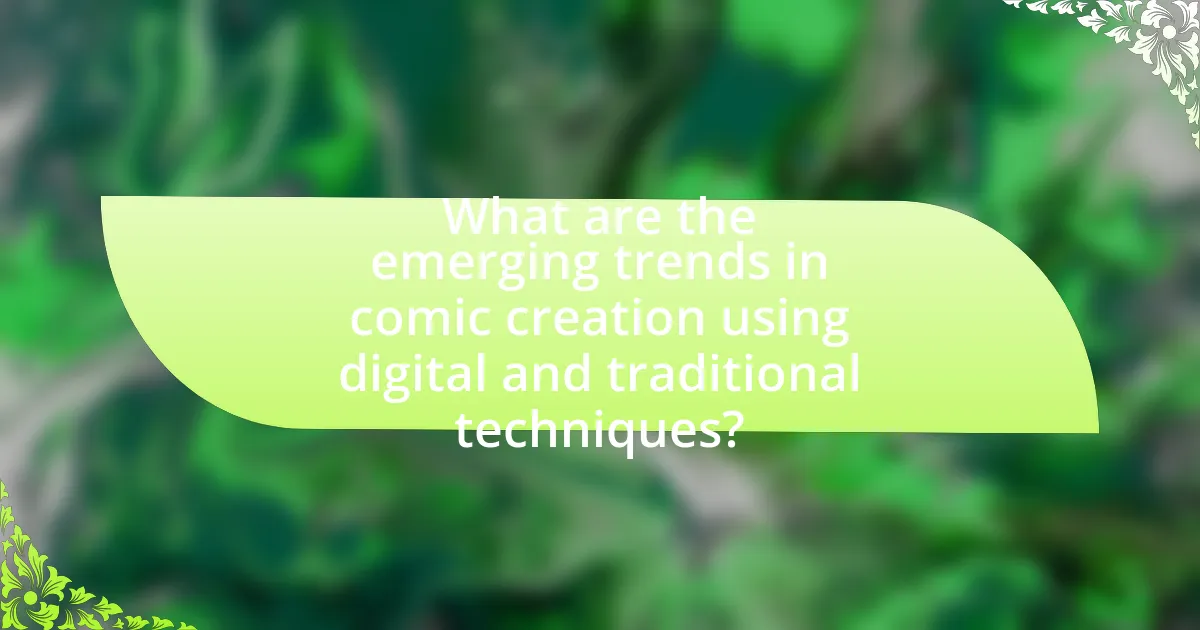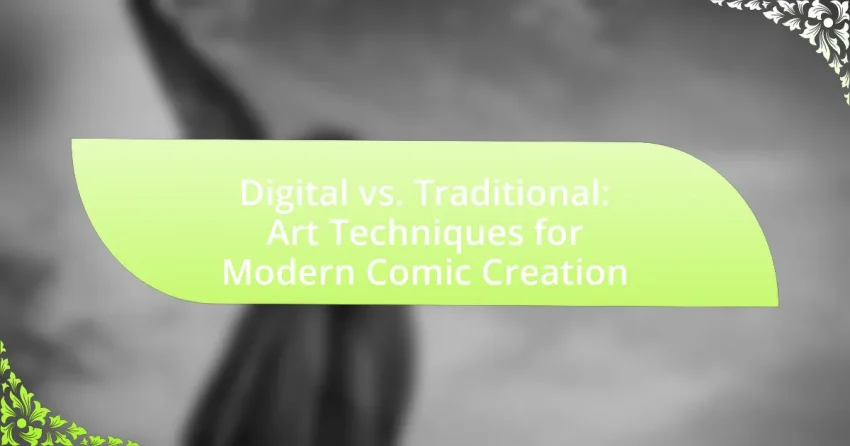The article examines the key differences between digital and traditional art techniques in comic creation, highlighting how each medium influences the artistic process, efficiency, and final outcomes. It discusses the unique characteristics, advantages, and disadvantages of both digital and traditional methods, as well as the factors that influence an artist’s choice of medium. Additionally, the article explores emerging trends in comic creation, the impact of technology on the art form, and best practices for artists looking to blend both techniques effectively. Through this analysis, the article provides a comprehensive overview of the evolving landscape of comic art in the context of modern techniques.

What are the key differences between digital and traditional art techniques in comic creation?
Digital art techniques in comic creation primarily utilize software and digital tools, while traditional art techniques rely on physical mediums like paper and ink. Digital methods allow for easy editing, layering, and the use of various brushes and effects, which can enhance creativity and efficiency. In contrast, traditional techniques often involve a more tactile experience, requiring skills in handling physical materials and tools, such as pencils, inks, and paints.
Additionally, digital art can facilitate faster production times due to the ability to undo mistakes and replicate elements, whereas traditional art may require more time for corrections and revisions. The permanence of traditional mediums can also lead to unique textures and finishes that digital art may struggle to replicate, despite advancements in digital rendering. These differences highlight the distinct approaches and outcomes associated with each technique in comic creation.
How does the medium influence the artistic process in comics?
The medium significantly influences the artistic process in comics by dictating the tools, techniques, and workflows available to artists. For instance, traditional mediums like ink and watercolor require different skills and approaches compared to digital tools, which offer features such as layers, undo options, and a vast array of brushes. This distinction affects not only the final aesthetic but also the speed and flexibility of the creative process. Research indicates that artists working digitally can produce work more rapidly due to the efficiency of digital tools, as noted in studies on digital art workflows. Thus, the choice of medium shapes both the technical execution and the overall artistic expression in comic creation.
What are the unique characteristics of digital art techniques?
Digital art techniques are characterized by their use of technology to create artwork, allowing for precision, versatility, and ease of modification. These techniques enable artists to utilize tools such as graphic tablets, software like Adobe Photoshop or Procreate, and various digital brushes that mimic traditional media while offering unique capabilities like layering, undo functions, and customizable textures. Additionally, digital art facilitates rapid experimentation and iteration, as artists can easily adjust colors, shapes, and compositions without the constraints of physical materials. The ability to share and distribute digital art online also enhances accessibility and collaboration among artists globally.
What are the defining features of traditional art techniques?
Traditional art techniques are characterized by the use of physical materials and manual processes to create artwork. These techniques often involve mediums such as oil, watercolor, acrylic paints, charcoal, and ink, which require specific skills and tools like brushes, palettes, and canvases. The application of these materials typically emphasizes texture, layering, and the artist’s hand, resulting in unique, tangible pieces that reflect individual style and technique. Historical practices, such as oil painting dating back to the 15th century, demonstrate the enduring nature of these methods, showcasing their significance in art history and their influence on contemporary practices.
What are the advantages and disadvantages of each technique?
Digital art techniques offer advantages such as flexibility, ease of editing, and access to a wide range of tools and effects, which can enhance creativity and efficiency in comic creation. For instance, artists can easily undo mistakes and experiment with different styles without the cost of materials. However, disadvantages include the potential for a steep learning curve with software and the risk of over-reliance on digital tools, which may hinder traditional skills.
Traditional art techniques provide advantages like a tactile experience and a unique aesthetic that many artists and audiences appreciate. The physicality of materials can lead to a more personal connection to the artwork. Conversely, disadvantages include limitations in editing, higher material costs, and the time-consuming nature of certain processes, which can slow down production.
How does digital art enhance efficiency in comic creation?
Digital art enhances efficiency in comic creation by streamlining the workflow through tools that allow for quick edits, layering, and instant color adjustments. Artists can utilize software features such as undo functions, customizable brushes, and digital asset libraries, which significantly reduce the time spent on revisions and iterations. For instance, a study by the University of Southern California found that digital tools can cut production time by up to 50% compared to traditional methods, enabling artists to focus more on creativity rather than technical constraints.
What limitations does traditional art impose on comic artists?
Traditional art imposes several limitations on comic artists, primarily in terms of flexibility, speed, and reproducibility. The use of physical materials, such as ink and paper, restricts artists to a fixed medium, making it challenging to make quick alterations or corrections. For instance, once ink is applied, mistakes can be difficult to rectify without starting over, which can slow down the creative process. Additionally, traditional art often requires more time for each page due to the manual techniques involved, such as inking and coloring, which can hinder productivity compared to digital methods that allow for faster editing and layering. Furthermore, traditional artworks are not easily reproducible; creating prints or copies requires additional steps and can lead to variations in quality, unlike digital art that can be duplicated with precision. These factors collectively limit the efficiency and adaptability of comic artists working within traditional frameworks.

How do artists choose between digital and traditional techniques?
Artists choose between digital and traditional techniques based on factors such as personal preference, desired outcomes, and the specific requirements of their projects. Personal preference plays a significant role, as some artists feel more comfortable with the tactile nature of traditional media, while others appreciate the versatility and efficiency of digital tools. Desired outcomes influence this choice as well; for instance, traditional techniques may be favored for their unique textures and organic feel, while digital methods allow for easier editing and experimentation. Additionally, project requirements, such as deadlines and collaboration needs, can dictate the choice, with digital techniques often providing faster turnaround times.
What factors influence an artist’s choice of medium?
An artist’s choice of medium is influenced by factors such as personal preference, the desired aesthetic, technical skills, and the intended audience. Personal preference plays a crucial role, as artists often gravitate towards mediums that resonate with their creative vision. The desired aesthetic impacts the choice, as different mediums can evoke varying emotional responses; for instance, digital mediums may offer a sleek, modern look, while traditional mediums like oil paint can provide texture and depth. Technical skills also dictate medium selection; an artist proficient in digital tools may prefer digital painting, while one trained in traditional techniques might choose watercolor or charcoal. Lastly, the intended audience can influence the medium, as certain styles may appeal more to specific demographics, such as younger audiences favoring digital art in comics.
How does an artist’s style affect their medium preference?
An artist’s style significantly influences their medium preference by dictating the techniques and materials that best express their creative vision. For instance, artists with a detailed, realistic style may prefer traditional mediums like oil paints or graphite, which allow for fine detail and texture. Conversely, artists who favor a more abstract or graphic style might gravitate towards digital mediums, as they offer flexibility and ease of manipulation. Research indicates that the choice of medium can enhance the effectiveness of an artist’s style; for example, a study published in the Journal of Visual Arts Research highlights that artists often select mediums that align with their stylistic goals, thereby optimizing their artistic expression.
What role does audience expectation play in medium selection?
Audience expectation significantly influences medium selection by guiding creators toward formats that resonate with their target demographic. For instance, younger audiences often expect digital comics due to their familiarity with technology and interactive elements, while older audiences may prefer traditional print formats that evoke nostalgia. Research indicates that 70% of comic readers aged 18-34 engage primarily with digital content, highlighting the importance of aligning medium choice with audience preferences to enhance engagement and satisfaction. Thus, understanding audience expectations is crucial for creators in selecting the appropriate medium for their work.
What are the common misconceptions about digital and traditional art?
Common misconceptions about digital and traditional art include the belief that digital art is less valuable or requires less skill than traditional art. This misconception arises from the perception that digital tools simplify the artistic process, while traditional art is often viewed as more authentic due to its physical nature. However, both forms of art require significant skill, creativity, and practice. For instance, a study by the National Endowment for the Arts highlights that artists working in both mediums undergo extensive training and develop unique techniques specific to their chosen format, demonstrating that the value and skill involved in both digital and traditional art are comparable.
Why do some believe traditional art is superior to digital art?
Some believe traditional art is superior to digital art due to its tangible nature and the unique qualities it offers, such as texture and depth. Traditional mediums like oil, watercolor, and charcoal allow for a physical interaction that can evoke emotional responses, which some artists and viewers find more authentic. Additionally, traditional art often involves a longer, more deliberate process, which can lead to a deeper connection between the artist and the artwork. Historical context supports this view, as many art movements, such as Impressionism and Expressionism, were rooted in traditional techniques that emphasized the artist’s hand and individual style, aspects that can sometimes be perceived as diminished in digital formats.
What myths exist about the capabilities of digital art?
Myths about the capabilities of digital art include the belief that it lacks authenticity and emotional depth compared to traditional art. Critics often argue that digital art is merely a product of technology, suggesting it requires less skill and creativity. However, studies show that digital artists often employ complex techniques and tools that demand a high level of expertise, similar to traditional mediums. Additionally, the versatility of digital art allows for innovative expressions that can evoke strong emotional responses, challenging the notion that it is inferior.

What are the emerging trends in comic creation using digital and traditional techniques?
Emerging trends in comic creation using digital and traditional techniques include the integration of augmented reality (AR) and virtual reality (VR) elements, which enhance reader engagement by providing interactive experiences. Additionally, the use of digital tools for traditional art styles, such as digital painting mimicking watercolor or ink, allows artists to combine the tactile feel of traditional methods with the efficiency of digital platforms. Furthermore, the rise of webcomics and digital distribution has shifted the focus towards serialized storytelling, enabling creators to reach global audiences more easily. These trends reflect a blending of techniques that cater to evolving consumer preferences and technological advancements in the comic industry.
How is technology shaping the future of comic art?
Technology is significantly shaping the future of comic art by enabling digital tools that enhance creativity and streamline production processes. Digital platforms allow artists to create, edit, and distribute their work more efficiently, utilizing software like Adobe Photoshop and Procreate, which offer advanced features such as layering, digital brushes, and instant feedback. Furthermore, the rise of webcomics and digital publishing has expanded the audience reach, allowing creators to connect directly with readers through platforms like Webtoon and Tapas. According to a 2021 report by Statista, the global digital comic market is projected to grow significantly, indicating a shift in consumer preferences towards digital formats. This evolution not only democratizes access to comic creation but also fosters innovation in storytelling techniques and visual styles.
What innovations are being introduced in digital comic creation?
Innovations in digital comic creation include the use of augmented reality (AR) and virtual reality (VR) technologies, which enhance reader engagement by allowing interactive storytelling experiences. Additionally, artificial intelligence (AI) tools are being developed to assist artists in generating artwork and dialogue, streamlining the creative process. For instance, platforms like Clip Studio Paint now incorporate AI features that can suggest poses and backgrounds, significantly reducing production time. Furthermore, blockchain technology is being utilized for digital rights management and to create unique, verifiable ownership of digital comics through non-fungible tokens (NFTs). These advancements are reshaping the landscape of comic creation, making it more accessible and innovative.
How are traditional techniques being adapted in modern comics?
Traditional techniques are being adapted in modern comics through the integration of digital tools that enhance the artistic process while preserving classic styles. Artists now utilize digital platforms to replicate traditional methods such as inking and coloring, allowing for greater flexibility and efficiency. For instance, programs like Adobe Photoshop and Clip Studio Paint offer brushes that mimic traditional media, enabling artists to achieve the same textures and effects found in hand-drawn illustrations. Additionally, the use of digital tablets allows for a seamless blend of sketching and finalizing artwork, which streamlines the workflow and reduces production time. This adaptation not only maintains the aesthetic qualities of traditional comics but also expands creative possibilities, as artists can easily experiment with different styles and techniques without the constraints of physical materials.
What best practices can artists follow when combining both techniques?
Artists can enhance their work by following best practices when combining digital and traditional techniques. First, they should establish a clear workflow that integrates both mediums, allowing for seamless transitions between digital and traditional processes. For example, artists can sketch traditionally and then scan their work into digital software for coloring and editing, which leverages the strengths of both methods.
Additionally, maintaining consistent styles across both mediums is crucial; artists should develop a cohesive visual language that translates well from paper to screen. This can be achieved by using similar color palettes and brush techniques in both environments.
Furthermore, artists should experiment with layering techniques, where traditional textures can be digitally enhanced, creating depth and richness in their artwork. This practice is supported by the fact that many successful comic artists, such as Mike Mignola, utilize a combination of both techniques to achieve unique visual effects.
Lastly, regular practice and exploration of both mediums will allow artists to discover new ways to merge their skills, ultimately leading to innovative and compelling comic creations.
How can artists effectively blend digital and traditional methods?
Artists can effectively blend digital and traditional methods by integrating both mediums in their creative process. For instance, an artist may start with traditional sketching on paper to capture initial ideas and then scan these sketches into digital software for further refinement and coloring. This approach allows artists to leverage the tactile quality of traditional materials while utilizing the versatility and efficiency of digital tools. Research indicates that artists who combine these methods often report enhanced creativity and improved workflow, as seen in studies highlighting the benefits of mixed media in art education.
What tips can help artists transition between digital and traditional techniques?
Artists can effectively transition between digital and traditional techniques by practicing consistent sketching in both mediums. This practice helps develop a strong foundation in drawing skills that are transferable across formats. Additionally, artists should familiarize themselves with the tools and materials specific to each medium, such as understanding the differences in brush techniques for digital painting versus traditional painting. Engaging in hybrid projects that incorporate both digital and traditional elements can also facilitate a smoother transition, allowing artists to explore the strengths of each medium. Furthermore, studying the work of artists who successfully blend both techniques can provide valuable insights and inspiration.
